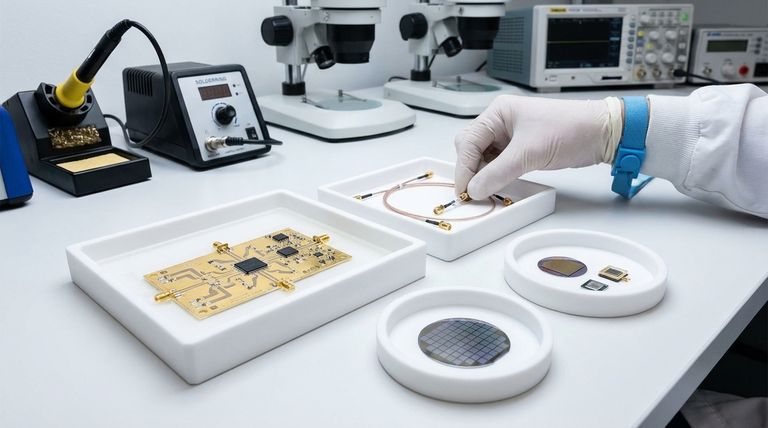In the electrical and electronics industries, Polytetrafluoroethylene (PTFE) is primarily valued for two core properties: its exceptional electrical insulation and its remarkable resilience in harsh environments. This makes it a critical material for high-performance applications, including insulating high-frequency cables, manufacturing printed circuit boards, and fabricating components for semiconductors and sensors.
While many materials offer electrical insulation, PTFE's unique combination of a low dielectric constant, extreme temperature tolerance, and chemical inertness makes it the material of choice for demanding applications where signal integrity and operational reliability are non-negotiable.

The Fundamental Properties Driving PTFE Adoption
To understand where PTFE is used, we must first understand why it is chosen over other materials. Its value stems from a powerful set of inherent characteristics.
Superior Electrical Insulation
PTFE has an exceptionally low dielectric constant and a low loss factor. This means it does not store much electrical energy and allows electromagnetic fields to pass through with minimal signal loss, which is critical for high-frequency applications.
This property ensures signal integrity in sensitive circuits, preventing signal degradation in high-speed data cables and radio frequency (RF) components.
Extreme Thermal Stability
PTFE maintains its integrity and insulating properties across a very wide temperature range. It can withstand the high temperatures generated by high-power electrical components like motors and transformers without melting or degrading.
This thermal resilience is also essential for electronics deployed in demanding environments, from aerospace systems to industrial control devices.
Unmatched Chemical Inertness
PTFE is resistant to nearly all chemicals and solvents. This makes it invaluable in environments where components might be exposed to corrosive fluids or gases, such as in chemical processing plants or during the semiconductor manufacturing process itself.
Key Applications in Electrical Systems
These core properties translate directly into specific, high-value applications where lesser materials would quickly fail.
Wire and Cable Insulation
The most common application is as a high-performance insulator for wires and cables. You will find it used extensively in coaxial cables for RF signals, hookup wires inside complex electronic assemblies, and critical wiring harnesses in the aerospace industry.
Its function is to prevent short circuits and protect the signal's integrity from external interference, especially under thermal stress.
High-Frequency Printed Circuit Boards (PCBs)
For circuits operating at microwave or radio frequencies, the PCB material itself can impact performance. PTFE's low dielectric constant makes it an ideal substrate for high-frequency PCBs, minimizing signal loss and ensuring the circuit performs as designed.
Motors, Transformers, and Capacitors
In power components like motors and transformers, heat and electrical stress are constant challenges. PTFE is used as an insulating film or liner to separate windings and other conductive parts, preventing electrical breakdown at high operating temperatures.
Understanding the Trade-offs
Despite its advantages, PTFE is not a universal solution. A sound engineering decision requires acknowledging its limitations.
Material Cost
PTFE is a premium material and is significantly more expensive than common insulators like PVC or polyethylene. Its use is typically justified only when its high-performance characteristics are a strict requirement.
Mechanical Properties
Compared to many engineering plastics, PTFE is relatively soft and can be susceptible to creep under sustained load. It is not typically used for structural components unless it is reinforced with fillers.
Modifiability with Fillers
The properties of PTFE can be intentionally altered. For instance, while it is an excellent insulator, it can be mixed with fillers like copper to enhance thermal or electrical conductivity for specific applications like thermal management or static dissipation.
Making the Right Choice for Your Application
Selecting the right material depends entirely on the technical and budgetary constraints of your project.
- If your primary focus is high-frequency signal integrity (e.g., RF circuits): PTFE's low dielectric constant is essential for PCB substrates and coaxial cables to minimize signal loss.
- If your primary focus is reliability in harsh environments (e.g., aerospace, industrial sensors): PTFE's combination of thermal stability and chemical resistance provides unparalleled protection for wiring and components.
- If your primary focus is cost-sensitive, low-power consumer electronics: A more common insulator like PVC or polyethylene is often a more practical and economical alternative.
Ultimately, selecting PTFE is a deliberate engineering decision to prioritize performance and longevity in applications where standard materials would fail.
Summary Table:
| Key Property | Benefit for Electrical/Electronics | Common Application |
|---|---|---|
| Low Dielectric Constant | Minimal signal loss at high frequencies | High-frequency PCBs, Coaxial Cables |
| Extreme Thermal Stability | Reliable performance from cryogenic to high temps | Motor/Transformer Insulation, Aerospace Wiring |
| Superior Chemical Inertness | Protection against corrosive environments | Semiconductor Manufacturing, Industrial Sensors |
| High Dielectric Strength | Excellent electrical insulation | Capacitors, Hookup Wires |
Need high-performance PTFE components for your critical application?
KINTEK specializes in manufacturing precision PTFE components—including seals, liners, labware, and custom parts—for the semiconductor, medical, laboratory, and industrial sectors. We ensure your components deliver the unmatched electrical insulation, thermal stability, and chemical resistance required for reliability in the most demanding environments.
From prototypes to high-volume orders, our custom fabrication expertise guarantees a perfect fit for your needs. Contact KINTEK today to discuss your project and receive a quote.
Visual Guide

Related Products
- Custom PTFE Parts Manufacturer for Teflon Containers and Components
- Custom PTFE Parts Manufacturer for Teflon Parts and PTFE Tweezers
- Custom PTFE Sleeves and Hollow Rods for Advanced Applications
- Custom PTFE Teflon Balls for Advanced Industrial Applications
- Custom PTFE Square Trays for Industrial and Laboratory Use
People Also Ask
- Why is dimensional stability a concern when machining PTFE? Ensure Accurate, Stable PTFE Components
- Why is PTFE considered a significant discovery? A Material That Revolutionized Industry
- What are some important physical property values for PTFE? Master Its Extreme Performance for Demanding Applications
- How is PTFE used in industrial processes? Maximize Safety and Efficiency
- What is the hardness range of PTFE on the Shore D scale? Leveraging Its Softness for Superior Performance



















